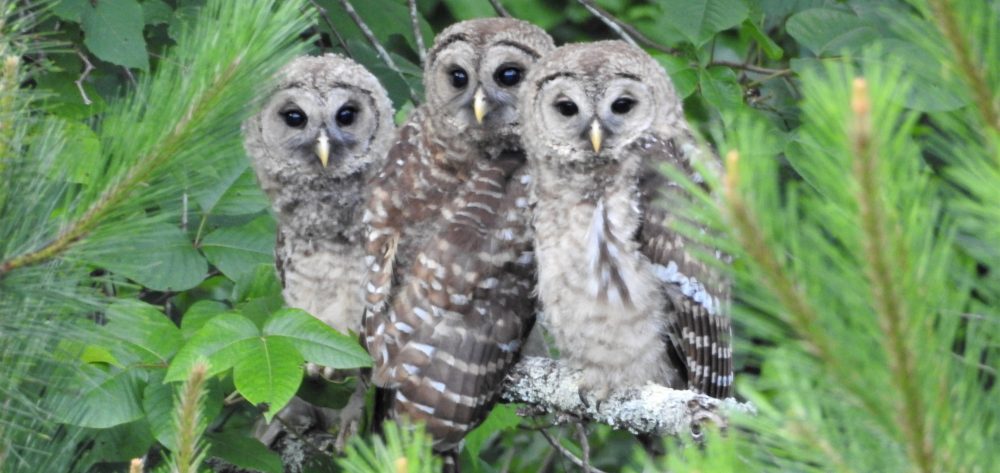While looking for birds during the Audubon Christmas Bird Count on a cold, early-January day, my team of birders had the unexpected and delightful surprise to witness a beautiful coyote taking in some sunshine. Although I regularly come in close contact with coyotes at AWARE (and wrote about helping to raise and release coyotes in Back to the Wild), seeing a healthy one in the wild, even at a distance, was thrilling. I’m reassured to know enough wildness still exists where I live for these amazing animals to survive, yet I worry for their safety, too. Unfortunately, coyote sightings still make most people uneasy, and they continue to be persecuted on a national level. How has the dog achieved the status of “Man’s Best Friend,” while its wild cousins, especially the coyote, continue to be feared and persecuted?
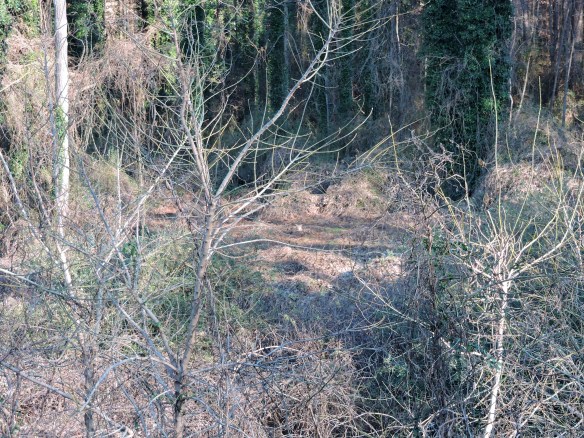
Without our binoculars, I don’t think we would have ever spotted this coyote.
In order to understand why coyotes are so misunderstood, a few historical facts are worth mentioning. In the early history of wildlife management, as our nation expanded westward, Americans generally agreed that predators such as wolves, coyotes, and panthers should be killed indiscriminately. In 1909, under pressure from livestock owners, Congress began funding a large-scale predator control program aimed at large carnivores from eagles to bears. Both the Red Wolf and the Gray Wolf were completely wiped out in the United States in the ensuing decades and have only recently been reintroduced to the American landscape. Sadly, this predator control program persists even today with the government killing approximately 100,000 carnivores each year–using methods that include trapping, aerial gunning, poisoning, and killing young in their dens–and spending an estimated $100 million of our annual federal budget, with very little regulation, to do it. Coyotes are targeted in particular. Statistics provided by the United States Department of Agriculture indicate that more than 75,000 coyotes were killed in 2013 (
The Toll Taken by Wildlife Services). Although most livestock losses come from weather, disease, illness, and birthing problems, coyotes continue to be persecuted, in spite of the vital role they play in maintaining healthy ecosystems. These federally-funded predator control activities, driven by narrow agricultural interests, kill untold numbers of non-target animals and ignore the public need for a healthy environment, fiscal responsibility, and safe public lands.
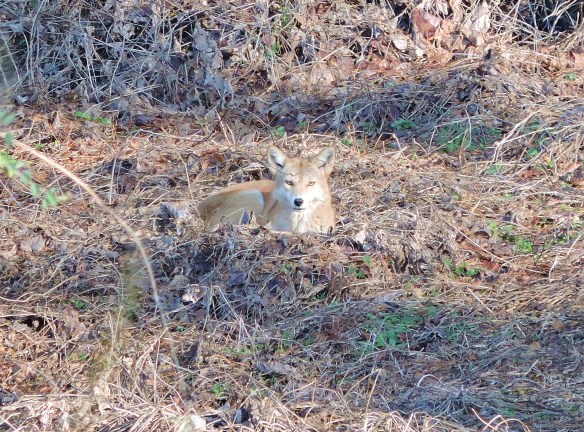
Coyotes play an integral role in healthy ecosytems and pose little threat to humans, livestock, or pets when a few precautions are taken.
Little suggests these control measures are working anyway. In spite of persecution from humans, coyotes not only have failed to decline in numbers, but have expanded their range in all directions, flourishing in a wide range of habitats from the Canadian tundra to metropolitan cities. In fact, scientists and wildlife officials estimate coyote numbers to be at an all-time high, and studies show that efforts to reduce the population usually end up increasing it instead. In short, the resilient and resourceful coyote is an amazing evolutionary success. Many factors have contributed to this success. Until recent decades, coyotes lived only in western North America, often in harsh, dry climates with scorching days and freezing nights that enabled them to adapt to a wide variety of conditions. The eradication of wolves boosted coyote populations, both by eliminating their biggest predator and by making more prey available to them. Humans further contributed to the coyote’s expanding range by clearing forests and creating fragmented habitats ideal for small mammals, the coyote’s favorite prey. And, interestingly enough, many wildlife biologists argue that the overkill of the species has served only to transform the coyote into a more adaptable, intelligent, and indestructible animal since the individuals that escape the guns, traps, and poisons are those that possess the keenest survival instincts. Studies also show that efforts to control coyote populations actually cause a population
increase within a short time. In a stable family group (a breeding pair and one or two offspring, known as a “pack”), only the alpha male and female reproduce, keeping the population in check. When individuals are killed and more resources become available, females tend to have larger litters with higher survival rates. If an alpha female is killed, other females in the area will seize the opportunity to have litters of their own. In any case, the population ultimately increases quickly. The coyote’s generalized diet gives it an additional evolutionary edge. Though excellent hunters, coyotes are also opportunistic, dining on carrion, insects, nuts, fruits, grasses, and other vegetation, in addition to small prey. In spite of our best efforts to defeat it, the coyote has adapted and persevered. Like the well-known Wile E. Coyote of cartoons, the coyote just keeps bouncing back.
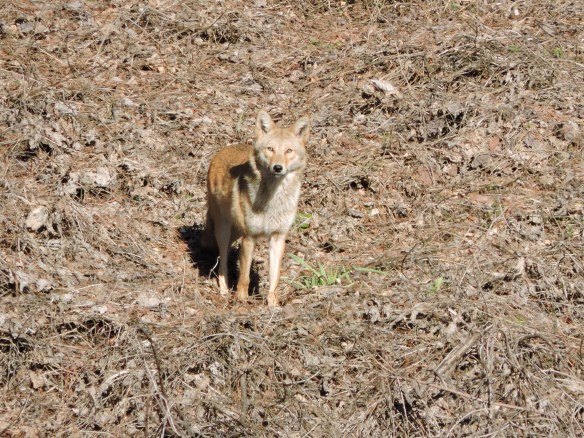
Intelligent, adaptable, and family-oriented, coyotes have outwitted attempts to eradicate them. And how can you resist this face?!
As a top predator, coyotes play an integral role in the environment, helping to maintain healthy ecosystems and species diversity. Recent studies show coyotes may even be a benefit to declining bird populations by controlling mesopredators like raccoons that prey on bird eggs and young. (For a cool video about the importance of top predators, check out this amazing video:
How Wolves Change Rivers.) Although they are moving into our neighborhoods, their presence needn’t alarm us when we take a few precautions. Instinctively fearful of people, these animals go out of their way to avoid humans. (I tell people all the time I’d rather wrangle a coyote than handle a chipmunk). When people feed them, intentionally or unintentionally (by leaving pet food or garbage outside overnight, for example), coyotes may become less wary of our presence, which can lead to occasional sightings, but rarely more than that. Most of the time, coyotes go about their coyote business–living in small, close-knit family groups that hunt and play together, care for each other, and protect their territory from intruding coyotes and other predators. Having a healthy family group in your area is an asset, as coyotes help to control pest populations and maintain the balance of wildlife, including their own species. With minor adjustments we can learn to appreciate and coexist with these intelligent, adaptable canines. For me, seeing one during that chilly Christmas Bird Count was the best sighting of the day.
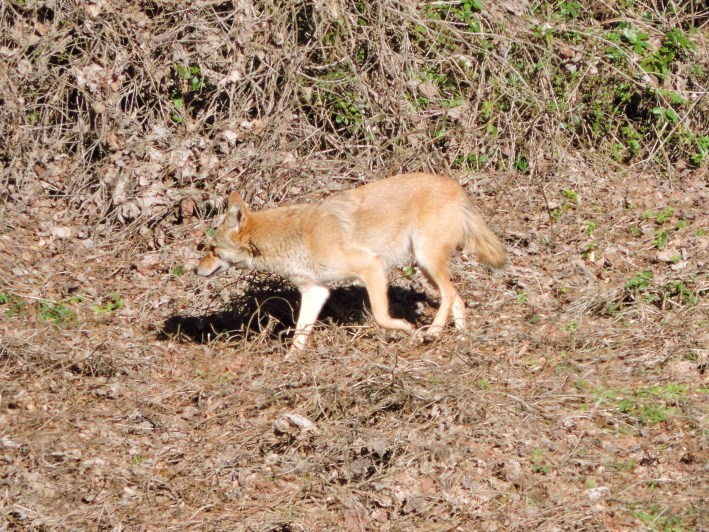
Coyotes typically avoid humans. This one looked at me for a minute, then trotted off.
DID YOU KNOW…?
In Georgia and many other states, coyotes receive very few protections. They may be hunted or trapped at any time of year and their pelts commercially sold. By law, coyotes trapped as “nuisances” may not be relocated. Trapped animals are either euthanized or sold to licensed hunting facilities where they are put in penned enclosures and hunted with dogs. Trapping is not a humane solution. Please find ways to coexist.
EDUCATED COEXISTENCE from Project Coyote
Urban landscapes offer an abundance of food, water, and shelter for coyotes. Take the following steps to prevent coyotes from being attracted to your home:
*Wildlife-proof garbage in sturdy containers with tight fitting lids.
*Don’t leave pet food outside.
*Take out trash the morning pick up is scheduled.
*Keep compost in secure containers.
*Keep fallen fruit off the ground. Coyotes eat fruit.
*Keep birdseed off the ground; seeds attract rodents which then attract coyotes. Remove
feeders if coyotes are seen in your yard.
*Keep barbecue grills clean.
*Eliminate accessible water sources.
*Clear away brush and dense weeds near buildings.
*Close off crawl spaces under decks and around buildings where coyotes may den.
*If you frequently see a coyote in your yard, make loud noises with pots, pans, or air horns, and haze the coyote with a water hose.
*Share this list with your neighbors; coexistence is a neighborhood effort.




